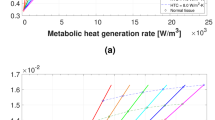Abstract
We studied the significance of the locoregional hyperthermic area observed by contact thermography in relation to the maximum density of tumor enhancement obtained by IV-DSA. The subjects were 34 patients with primary breast cancer. The thermal difference between the locoregional hyperthermic area and the surrounding mammary tissues was obtained, and the maximum density of tumor stain on IV-DSA was calculated from the time-density curve. Twenty-three (67.6%) patients had a locoregional hyperthermic area corresponding to the tumor. The higher the degree of thermal difference between the hyperthermic area and the surrounding tissues, the higher the maximum density of tumor enhancement. As the maximum density of tumor stain is considered to reflect the vascularity of the tumor, the degree of the locoregional hyperthermic area obtained by thermography may also reflect tumor vascularity.
Similar content being viewed by others
Abbreviations
- IV-DSA:
-
Intravenous digital subtraction angiography
References
Fay T, Henny GC: Correlation of body segmental temperature and its relation to the location of carcinomatous metastasis; Clinical observations and response to methods of refrigeration.Surg Gynecol Obstet 66:512–524, 1938.
Isard HJ, Sweitzer CJ, Edelstein GR: Breast thermology; A prognostic indicator for breast cancer survival.Cancer 62:484–488, 1988.
Head JK, Wang F, Elliott RT: Breast thermography is a noninvasive procedure that predicts tumor growth rate in breast cancer patients.Ann NY Acad Sci 689:153–158, 1993.
Takai Y, Yokoe T, Iino Y,et al: Breast contact- thermography; A prognostic indication for breast cancer.Jpn J Breast Cancer 8:259–262, 1993 (Abstract in English).
Kubo K: “Auto-thermography”.Gann 28:1503–1515, 1982.
Watanabe O, Haga S, Shimizu T,et al: Relationship between staining by digital subtraction angiography and vascularity in breast cancer; Analysis of the time- density curve and the results of staining for factor VIII- related antigen/von Willebrand factor.Breast Cancer Res Treat 33:269–273, 1995.
Watanabe O, Haga S, Kobayashi K,et al: Digital subtraction angiography for breast cancer; Analysis of the time desity curve.Jpn J Breast Cancer 7:582- 586, 1992 (Abstract in English).
Nishimura R, Nagao K, Matsuoka Y,et al: Studies on the usefulness of contact thermography in breast conserving surgery.Jpn J Breast Cancer 8:102–109, 1993 (Abstract in English).
Weidner N, Semple JP, Welch WR,et al: Tumor angiogenesis and metastasis-correlation in invasive breast carcinoma.N Engl J Med 324:1–8, 1991.
Author information
Authors and Affiliations
About this article
Cite this article
Haga, S., Watanabe, O., Shimizu, T. et al. Relation between locoregional hyperthermic area detected by contact thermography and the maximum density of tumor stain obtained by IV-dsa in breast cancer patients. Breast Cancer 3, 33–37 (1996). https://doi.org/10.1007/BF02966960
Received:
Accepted:
Issue Date:
DOI: https://doi.org/10.1007/BF02966960




